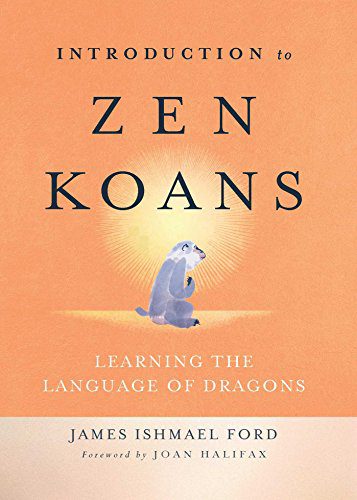Emptiness: A Practical Guide for Meditators
GUY ARMSTRONG
Somerville, Mass.: Wisdom Publications, 2017. 307 pp., paper, $17.95.
Introduction to Zen Koans: Learning the Language of Dragons
JAMES ISHMAEL FORD
Wisdom Publications, 2018. 248 pp., paper, $17.95.
Reviewed by Dhananjay Joshi
Of course the bird we see and hear exists. It exists, but what I mean by that may not be exactly what you mean.
—Shunryu Suzuki Roshi
To come across one good book on a topic like emptiness is what I would call a blessing. To get two is a major blessing!
Emptiness is hard to understand, even though it is a central component of religious teaching. The computer mouse I use feels hard to touch, and my mindfulness training says to feel the hardness and the smooth surface. How do I know that it is empty?
Guy Armstrong, a guiding teacher at Insight Meditation Society in Barre, Massachusetts, has written a book that is practical and easy to follow, especially for beginners, and includes several meditations. The book is in four parts: “Self,” “Phenomena,” “Awareness,” and “Compassion.” The first three parts are based on traditional Buddhist schools, mostly the Theravada Pali canon. The last part is more contemporary.
Emptiness, a translation of the Sanskrit word shunyata, can have a number of meanings. The Buddha discerned that human experience is empty of a self. A present-day interpretation points to a state of mind where we are “in touch with the present moment and not preoccupied with wants, needs, or issues of past or future.”
The section on “Self” is detailed and profoundly enlightening. When we say self, we are saying I, me, and mine. The Buddha said one can use these words, but one should not be confused. The world is empty of self, and the two understandings, absence of self and emptiness, are synonymous.
How do we relate this to our day-to-day experience? There are six ways: our body; ourselves as owners of our body; our emotions; ourselves as owner of our emotions; as an observer; and all of the above. How do these experiences align with the four basic assumptions associated with the self: continuity (we think self is permanent), control (we think self has control over body and mind), independence (we think “I” am seeing), and singleness (we believe we are one person and not two)? The self, as a combination of body, mind, owner, and observer, fails the test of the assumptions. Our experiences are changing moment to moment, and our notion of control is an illusion. What is real, then?
The Buddha said that what makes up a person is the six sense bases and the five aggregates of form, feelings, perceptions, volitional formations, and consciousness. The question again is, are these valid grounds for validation of self, or for some kind of ownership? This points us to a basic cycle: we own because we desire. We become attached because we desire. We suffer when things inevitably change or are broken or die. The great Thai forest master Ajahn Chah explained, referring to a glass of water he had: “You say, ‘don’t break my glass!’ Can you prevent something that is breakable from breaking? If it doesn’t break now, it will break later. If you don’t break it, someone else will. When someone else doesn’t, one of the chickens will. When you use this glass, you should reflect that it is already broken. . . . Develop this understanding. Use the glass, look after it, until one day, it slips out of your hand and breaks. . . . ‘Smash!’. . . no problem. Why is there no problem? Because you saw its brokenness before it broke.”
This is the key to understanding emptiness. How do we assimilate it? Armstrong helps us by giving practical instruction in vipassana, insight meditation. As Anagarika Munindra said, “If you want to understand your mind, sit down and observe it.” We deconstruct our illusions and then see things as they are. Armstrong gives a profound description of how observing autopsies in a local hospital in Bangkok gave him a different insight into our experiences.
The final step in our understanding of emptiness or no-self is to go beyond self. We leave behind blind identifications and develop the three qualities that Armstrong says have the capacity to help us bear the burden of emptiness: compassion, patience, and faith. We practice wholesome action by becoming aware in six different ways: before we act; while we act; after we have acted; in our relationships; in habitual behaviors; and also in mysterious ways we don’t understand. We use karma to change karma and then to end karma! This is called “abiding in emptiness.”
The section “Phenomena” returns us to the realm of the objects of the six senses and asks: in what way do they exist? How do they arise and pass away? The Buddha gave a discourse called A Lump of Foam to address the emptiness of phenomena. Everything is void, hollow, and as insubstantial as a lump of foam on a river.
Armstrong also talks about the seeming paradox in emptiness. Things exist, but they don’t really exist. The Heart Sutra states, “Form is emptiness, emptiness is form.”
James Ishmael Ford’s Introduction to Zen Koans leads us to the land of paradox. The word koan is frequently translated as puzzle or riddle. I like Aitken Roshi’s meaning: “a matter to be cleared.” The language of koans is called the “language of the dragons” because it can be enlightening as well as terrifying at times. It is the language of the opposites. Zen Master Huineng had this advice: “If in questioning you, someone asks about being, answer with non-being. If he asks about non-being, answer with being. If she asks about the ordinary person, answer in terms of the sage. If she asks about the sage, answer in terms of the ordinary person. By this method of opposites mutually related there arises the understanding of the Middle way. For every question that you are asked, respond in terms of its opposite.”
Ford’s book is divided in three parts: “The Heart of Zen,” “The Practices of Zen,” and “Living Zen.” Ford is a great storyteller; he makes koan practice approachable and not so much like working with the dragons. He quotes Zen Master Seung Sahn’s example of what emptiness means: “Here is a wooden chair. It is brown. It is solid and heavy. It looks like it could last a long time. You sit in the chair and it holds up your weight. You can place things on it. But then you light the chair on fire and leave. When you come back later, the chair is no longer there! This thing that seemed so solid and strong and real is now just a pile of cinder and ash, which the wind blows around. This example shows how the chair is empty: it is not a permanent, abiding thing. It is always changing. It has no independent existence. Over a long or short time, the chair will eventually change and become something other than what it appears. So this brown chair is complete emptiness. But though it always has the quality of emptiness, this emptiness is form: you can sit in the chair, and it will still hold you up.”
Zen practice requires three things: great doubt, great faith, and great determination. The most famous koan is Zhaozhou’s mu. A student comes to Zhaozhou and asks, “Does a dog have Buddha nature?” Zhaozhou replies, “Mu.” Mu means no, but that is not all. It is an invitation to delve into Great Emptiness. It means, “Although it is, it isn’t and although it isn’t, it is.”
I am tempted to ask: Ajahn Chah’s glass of water and Seung Sahn’s brown chair—are they the same or different? The two books would answer.
***
Dhananjay Joshi is a professor of statistics who has studied Hindu, Zen, and vipassana meditation for forty years. He is a regular reviewer for Quest and volunteers in the archives department of the TSA. This review was first published at the Theosophical Society’s “Book Reviews 2019“
***













